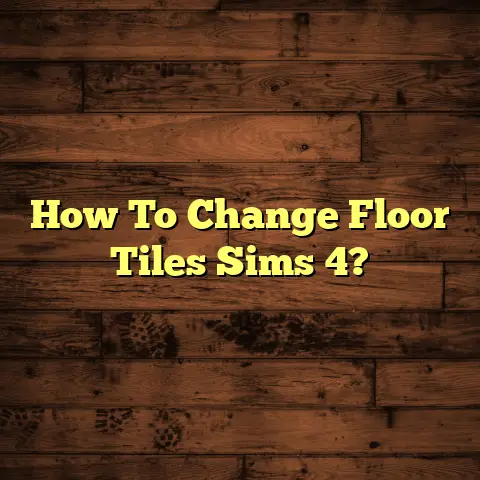Vinyl Plank Direction Guide (8 Layout Hacks!)
As a flooring contractor, I’ve seen firsthand how advancements in technology have transformed vinyl planks into a go-to option for homeowners and designers alike.
They mimic the look of natural materials like hardwood and stone, but with added benefits like water resistance and affordability.
But here’s a secret: the direction you lay your vinyl planks can dramatically impact the look and feel of your space.
That’s why I’m diving into this comprehensive
guide, sharing 8 layout hacks to help you
transform your space with vinyl plank flooring.
Let’s get started!
Section 1: Understanding Vinyl Plank Flooring
So, what is vinyl plank flooring anyway?
Simply put, it’s a multi-layered synthetic flooring product designed to replicate the look of natural materials like wood or stone.
It’s typically composed of several layers, including:
- A wear layer: This is the top layer that protects the floor from scratches, stains, and wear and tear.
- A print layer: This layer features a high-resolution image of wood, stone, or other materials.
- A core layer: This provides the floor with stability and water resistance.
- An underlayment (sometimes): This layer provides cushioning and sound absorption.
There are different types of vinyl plank flooring available, including:
- Luxury Vinyl Tile (LVT): This is a
premium option that offers realistic textures
and visuals.
It’s thicker and more durable than standard vinyl plank flooring. - Sheet Vinyl: This comes in large rolls and
is typically used in bathrooms and kitchens.
While it’s waterproof, it doesn’t offer the same realistic look as LVT.
What makes vinyl plank flooring so popular? Well, there are several advantages:
- Durability: It’s resistant to scratches, stains, and water damage.
- Ease of Maintenance: It’s easy to clean and requires minimal upkeep.
- Sound Absorption: It helps to reduce noise levels in your home.
- Affordability: It’s generally more affordable than natural materials like hardwood or stone.
- DIY-Friendly: Many vinyl plank options are designed for easy installation, making it a great choice for DIY enthusiasts.
Section 2: The Importance of Plank Direction
Okay, now let’s talk about why plank direction
matters.
I can’t stress this enough: the way you
lay your vinyl planks can completely change the
look and feel of a room.
Think of it like this: plank direction can influence how we perceive the size, shape, and flow of a space.
Here’s how:
- Visual Perception: Planks laid lengthwise can make a room appear longer, while planks laid widthwise can make it appear wider.
- Natural Light: The direction of planks can affect how light reflects off the floor, creating different visual effects.
- Room Flow: Planks can be used to guide the eye and create a sense of movement through a space.
Consider natural light, for example.
If you have
a room with a large window, laying the planks
parallel to the light source can enhance the
natural brightness and create a more open feel.
On the other hand, if you lay the planks perpendicular to the light source, it can create more shadows and texture, adding depth and character to the room.
Room dimensions also play a crucial role.
In a
narrow hallway, laying the planks lengthwise can
emphasize the length of the space, making it feel
more spacious.
In a smaller room, laying the planks diagonally can create the illusion of more square footage.
The concept of visual flow is also important.
You
want the plank direction to guide the eye and
create a sense of continuity throughout your home.
For example, if you have an open-concept living area, you might want to lay the planks in the same direction throughout the entire space to create a seamless look.
Section 3: 8 Layout Hacks for Vinyl Plank Direction
Alright, let’s get into the fun part: the layout
hacks!
I’m going to share 8 proven techniques
that I’ve used countless times to transform spaces
with vinyl plank flooring.
1. Hack 1: Diagonal Installation
Want to add a touch of drama and make a small room
feel bigger?
Try installing your vinyl planks
diagonally.
This layout creates a dynamic effect that draws the eye and makes spaces appear larger than they actually are.
It works by tricking the eye into perceiving more distance across the room.
Tips for Diagonal Installation:
- Accurate Measurements: Measuring and
cutting planks for a diagonal layout requires
precision.
Take your time and double-check your measurements before making any cuts. - Start at the Center: Find the center of
the room and work your way outwards.
This will help you maintain a consistent angle throughout the installation. - Use a Chalk Line: Use a chalk line to
create a straight reference line for your
diagonal layout.
This will help you keep your planks aligned. - Waste Factor: Be prepared for more waste
than with a straight layout.
Diagonal installations typically require more cuts, so order extra material to account for the wastage.
I usually suggest adding 15-20% more material.
For example, I once used a diagonal layout in a
small, square living room.
The homeowner was
amazed at how much larger and more open the space
felt after the installation.
2. Hack 2: Straight Layout for Narrow Spaces
If you’re dealing with a narrow hallway or a small, rectangular room, a straight layout is your best bet.
This simple yet effective technique involves laying
the planks parallel to the longest wall.
By
emphasizing the length of the room, you can create
a sense of spaciousness and flow.
Why This Works:
- Enhances Length: Aligning planks with the longest wall draws the eye down the length of the space, making it feel longer.
- Simplicity: A straight layout is relatively easy to install, making it a great option for DIYers.
- Clean Look: It creates a clean, uncluttered look that’s perfect for minimalist designs.
Pro Tip:
- Consider the Entryway: If the hallway leads into another room, consider continuing the straight layout into the adjacent space to create a seamless transition.
I remember working on a long, narrow hallway in an
older home.
The homeowner was concerned that the
hallway felt cramped and unwelcoming.
By using a
straight layout and aligning the planks with the
longest wall, we were able to transform the space
into a bright and inviting entryway.
3. Hack 3: Herringbone Pattern
Looking to add a touch of elegance and
sophistication to your space?
The herringbone
pattern is a classic choice that never goes out of
style.
This timeless layout involves arranging the planks in a zigzag pattern, creating a visually stunning effect.
How to Achieve the Herringbone Pattern:
- Preparation is Key: Start by finding the
center of the room and marking a reference line.
This will help you maintain a consistent pattern throughout the installation. - Cutting Planks: You’ll need to cut the
planks at a 45-degree angle to create the
zigzag pattern.
Use a miter saw for accurate cuts. - Alternating Directions: Lay the planks in
alternating directions, creating a “V” shape.
Make sure the ends of the planks meet at a 90-degree angle. - Patience is a Virtue: The herringbone pattern can be time-consuming to install, so be patient and take your time.
Step-by-Step Guide:
- Find the Center: Locate the center of the room and draw a perpendicular line.
- First Plank: Place the first plank along the center line, aligning one end with the line.
- Second Plank: Place the second plank perpendicular to the first, forming a 90-degree angle.
- Continue the Pattern: Continue laying the planks in alternating directions, creating the herringbone pattern.
- Cut and Fit: Cut the planks as needed to fit along the walls.
I once installed a herringbone pattern in a formal
dining room.
The homeowner was thrilled with the
results, saying that it added a touch of
sophistication and elegance to the space.
4. Hack 4: Mixed Widths for Texture
Want to add visual interest and create a more
textured floor?
Consider using planks of varying
widths.
This technique involves mixing planks of different widths to create a more dynamic and visually appealing floor.
Why This Works:
- Adds Depth: Varying widths create depth and dimension, making the floor more visually interesting.
- Rustic Charm: It can create a rustic, farmhouse-inspired look that’s perfect for casual spaces.
- Unique Look: It’s a great way to create a unique and personalized floor that stands out from the crowd.
Where This Works Best:
- Living Rooms: Adds character and warmth.
- Bedrooms: Creates a cozy and inviting atmosphere.
- Kitchens: Adds visual interest and breaks up the monotony of a large space.
Tips for Using Mixed Widths:
- Plan Your Layout: Before you start installing, plan your layout and decide how you want to arrange the different widths.
- Randomize the Pattern: Avoid creating a
repetitive pattern.
Randomize the placement of the different widths to create a more natural look. - Use a Consistent Color: Stick to a consistent color palette to ensure that the different widths blend together seamlessly.
I recently used mixed-width planks in a client’s
living room.
They wanted a floor that was both
stylish and unique.
By using planks of varying
widths, we were able to create a floor that was
full of character and visual interest.
5. Hack 5: Bordering for Definition
Want to define a space or create a custom look?
Adding a border around a room can be a great way to
achieve this.
This technique involves installing a border of vinyl planks around the perimeter of the room, creating a visual frame that defines the space.
Why This Works:
- Defines Spaces: It helps to define the boundaries of a room, making it feel more contained and intentional.
- Adds Visual Interest: It adds a touch of sophistication and visual interest to the floor.
- Custom Look: It allows you to create a custom look that complements your existing decor.
Different Border Styles:
- Single Border: A simple border consisting of a single row of planks.
- Double Border: A more elaborate border consisting of two rows of planks.
- Contrasting Border: A border that uses a different color or material than the main floor.
Materials That Complement Vinyl Planks:
- Wood: A natural wood border can add warmth and texture to the floor.
- Stone: A stone border can create a more formal and elegant look.
- Metal: A metal border can add a touch of modernity and industrial chic.
I often use borders to define spaces in open-concept
homes.
It’s a great way to create distinct zones
without completely separating the rooms.
6. Hack 6: Room Transition Techniques
One of the biggest challenges when installing vinyl plank flooring is transitioning between different types of flooring or rooms.
You want to maintain visual continuity while also ensuring a smooth and safe transition.
Methods for Transitioning:
- Transition Strips: These are metal or plastic strips that cover the gap between two different types of flooring.
- T-Moldings: These are used to transition between two floors of the same height.
- Reducer Strips: These are used to transition between two floors of different heights.
- Seamless Transitions: This involves carefully aligning the planks so that there is no visible transition.
Maintaining Visual Continuity:
- Use the Same Color: If possible, use the same color of vinyl plank flooring in both rooms to create a seamless transition.
- Align the Planks: Align the planks in both rooms so that they run in the same direction.
- Use a Border: Use a border to create a visual frame that connects the two rooms.
I always recommend using transition strips or
T-moldings to ensure a safe and durable transition.
It’s better to be safe than sorry!
7. Hack 7: Using Plank Direction to Enhance Lighting
Did you know that the direction of your vinyl planks can affect the way light interacts with the floor?
It’s true!
The way light reflects off the surface
of the planks can create different visual effects,
enhancing the natural brightness of the room or
adding depth and texture.
Tips for Enhancing Natural Light:
- Parallel to Light Source: Lay the planks parallel to the main source of natural light (e.g., a window) to maximize brightness and create a more open feel.
- Minimize Shadows: Avoid laying the planks perpendicular to the light source, as this can create more shadows and make the room feel darker.
- Use Light Colors: Opt for light-colored vinyl planks to reflect more light and brighten up the space.
I once worked on a dark and dreary basement.
By
laying the vinyl planks parallel to the small
windows and using a light color, we were able to
transform the space into a bright and inviting
living area.
8. Hack 8: Custom Layouts for Unique Spaces
Don’t be afraid to get creative and experiment with custom layouts!
Sometimes, the best solution is to break the rules and create a layout that’s tailored to your unique space and design preferences.
Examples of Unconventional Layouts:
- Geometric Patterns: Create a geometric pattern using different colors and shapes of vinyl planks.
- Random Layouts: Lay the planks in a random pattern to create a more organic and natural look.
- Combination Layouts: Combine different layouts in the same room to create a unique and visually interesting floor.
Encouraging Creativity:
- Experiment with Colors: Use different colors of vinyl planks to create a custom design.
- Mix and Match Patterns: Combine different patterns to create a unique and personalized floor.
- Think Outside the Box: Don’t be afraid to try something new and unconventional.
I once worked with a client who wanted a truly
unique floor for their home office.
We ended up
creating a custom geometric pattern using different
colors of vinyl planks.
The result was a stunning
and one-of-a-kind floor that perfectly reflected
their personality and style.
Conclusion
So, there you have it: 8 layout hacks to transform your space with vinyl plank flooring!
I hope this guide has given you some inspiration and ideas for your next flooring project.
Remember, the direction you lay your vinyl planks can have a huge impact on the overall look and feel of your space.
By considering these layout hacks and thinking creatively, you can create a floor that’s both beautiful and functional.
Don’t be afraid to experiment and try something
new.
The right direction can completely transform
a room!
Good luck with your flooring project, and happy installing!





